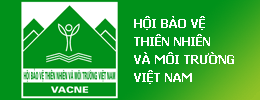MASTER THESIS ON CHARACTERISTICS OF TONKIN SNUB-NOSED MONKEY HABITAT SUPPORTED BY CeREC SUCCESSFULLY DEFENDED
Tonkin Snub-nosed Monkey Rhinopithecus avunculus (Dollman, 1912) (TSM) is a Vietnam endemic primate. Previously, the species was distributed in Yen Bai, Ha Giang, Tuyen Quang, Thai Nguyen and Bac Kan provinces, Northwest Vietnam. However, due to intensive illegal wildlife hunting, and massive destruction of natural forests during last centutry, nowaday, TSM is found only in a few forests in Ha Giang and Tuyen Quang provinces, with a total population of about 200-250 individuals. The species is ranked at “Critically Endangered – CR” both in 2007 Vietnam Red Data Book and 2024 IUCN Red List. TSM also belongs to the list of 25 World most endangered primate species. TSM is a strict arboreal primate, living in forests, walking on trees, feeding on forest plant parts. Therefore, forest quality plays a decisive role for the survival of the TSM population.
The watershed protection forest in Cao Ma Po, Tung Vai and Ta Van communes, Quan Ba district, Ha Giang province is home to a population of about 32-35 individuals of TSM. It is the second largest TSM population after the population in Khau Ca TSM Species and Habitat Conservation Area. This TSM population in Quan Ba forest is facing a high risk of extinction due to illegal wildlife poaching and habitat degradation. Well understanding of habitat charactistics will play important role in the TSM conservation. Unfortunately, habitat of TSM in Quan Ba watershed forest are still poorly studied. Therefore, during 2021 – 2024, CeREC has provided finnacial and technical support for Mr. Nguyen Tien Dat to conduct his masther thesis “Habtitat characteristics of Tonkin Snub-nosed Monkey Rhinopithecus avunculus in Quan Ba watershed protection forest, Ha Giang Province” to provide scientific basis for effective conservation of the TSM population in Quan Ba forest.

Mr. Nguyen Tien Dat is defencing his thesis at Vietnam University of Forestry in June 2024
In June 2024, Mr. Nguyen Tien Dat has sussecfully defenced his thesis at Vietnam University of Forestry. Key findings of his thesis are as following:
- TSM population in Quan Ba watershed forest consists of 4 - 8 group with total of 20 - 39 individuals. Its distribution area is about 5,000 ha while its core living area is about 1,000 ha in limestone forest. This population is reduced in number and faces with high risk of extinction.
- The TSM distribution area has 4,213.16 ha of natural forests (92.3% of the total area). There are 2 types of forests: Montane Evergreen Broadleaf (EB) forest (2280.4 ha; 54.1%) and Limestone EB forest (1,932.8 ha; 45.9%). The forest has been affected by human livelihood activities. Rich forest remains in about 223.1 ha (5.3% of the total forest area), the medium forest is about 2366.7 ha (56.2%), poor and rehabilitation forest is about 1623.4 ha (38.5/0%).
- The flora of the study area is very diverse, 648 species of vascular plants belonging to 364 genera, 129 families and 5 phyla were recorded. Of which, 19 species of 11 families are known as TSM food plants and 207 species (32%) has wood tree lifeform that can provide substrat for TSM arboreal locomotion.
- Four habitat types were determined, including: Low and medium affected limestone EB forests (SC1); Low and medium affected montane EB forest (SC2); Strongly affected and rehabilitation limestone EB forests (SC3); and Strongly affected and rehabilitation montane EB forest (SC4). TSM most frequently use SC1, less use SC2, rarely use SC3, and do not use SC4. The total area of habitats suitable for TSM (SC1 and SC2) is about 2,590 ha, accounting for 61.4% of the total forest area.
- Tall tree community has following key ecological indices: average tree density is 1491.3 trees/ha, diameter D1.3 ranges from 5 - 20 cm (80.11% of total species), average D1.3 is 14.97 cm, total BA per hectare is 41.04 m2. The families with the largest BA are Fagaceae, Magnoliaceae, Elaeocarpaceae, Araliaceae, Lauraceae, Fabaceae and Theaceae. The most dominant species are the Castanopsis chinensis, Castanopsis tonkinensis and Archidendron robinsonii.
- The main threats to the TSM habitat include: Farming of cardamom under the forest canopy; Collecting firewood to dry cardamom products; Selected cutting trees of high economic value; and Collecting non-timber forest products. The most critical threats are “Farming of cardamom under the forest canopy” and “Selective cutting of trees with high economic value ”.
- Seven urgent measures are proposed to conserve the TSM population and protect its habitat including: Strengthening control over wildlife hunting; Implementing regular forest protection patrol; Applying strict control of forest cardamom cultivation; Impoving forest qualitty; Implementing a community-based conservation program; Awareness raising education for local people; and Gazetting the study area as a TSM Nature Reserve.
Search
Main menu
- CeREC News - Bản tin CeREC
- Conservation Programs - Các chương trình bảo tồn
- Biodiversity Projects - Các dự án Đa dạng sinh học
- Environmental Projects - Các dự án Môi trường
- Training & Education - Đào tạo và Tập huấn
- Flagship Species - Loài trọng tâm của CeREC
- New Species- Loài mới phát hiện
- Law Enforcement - Thực thi pháp luật
- Publications - Các tài liệu xuất bản
- Technical Reports - Các báo cáo kỹ thuật
- Training Documents - Tài liệu đào tạo và Tập huấn
- Photo Reports - Phóng sự ảnh
- Nature Tours - Tham quan dã ngoại
- Partners & Donors - Đối tác và Nhà tài trợ
Recent Posts
Partners & Donors
CeREC thanks the following organizations for their generous support and sponsorship:





.jpg)


.jpg)

.jpg)


.jpg)
.jpg)
.jpg)




